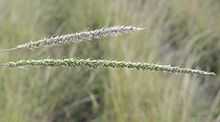Setaria vulpiseta
| Setaria vulpiseta | |
|---|---|
 | |
| Scientific classification | |
| Kingdom: | Plantae |
| (unranked): | Angiosperms |
| (unranked): | Monocots |
| (unranked): | Commelinids |
| Order: | Poales |
| Family: | Poaceae |
| Genus: | Setaria |
| Species: | S. vulpiseta |
| Binomial name | |
| Setaria vulpiseta (Lam.) Roem. & Schult. | |
| Synonyms[1] | |
| |
Setaria vulpiseta is a species of grass known by the common name plains bristlegrass. It is native to North America, where it occurs in Texas to Colorado to Arizona in the United States and northern and central Mexico.[2]
This perennial grass grows up to 3[2] to 4 feet tall.[3] It is yellow in color when mature. The hairy leaves are up to 10 inches long and have a ligule of hairs. The inflorescence is up to 5 inches long and is very narrow.[3]
This grass is a common forage in the American southwest. It is good grazing for livestock. The seed provides food for wildlife.[2] Its natural habitat is dry rangeland as well as low plains that receive flooding.[3]
References
- ↑ "The Plant List: A Working List of All Plant Species". Retrieved 14 December 2014.
- ↑ 2.0 2.1 2.2 Setaria vulpiseta. USDA NRCS Plant Fact Sheet.
- ↑ 3.0 3.1 3.2 Setaria vulpiseta. USDA NRCS Plant Guide.